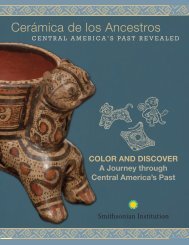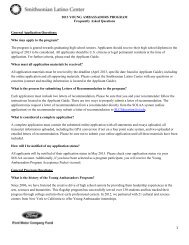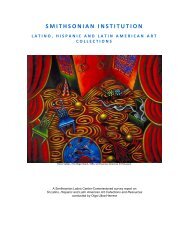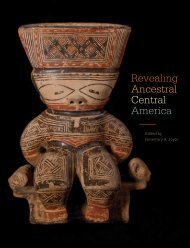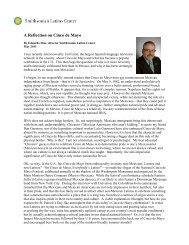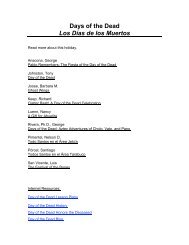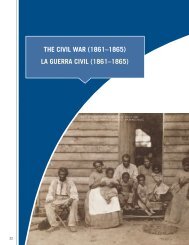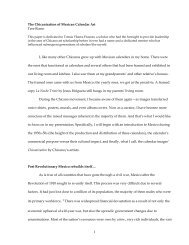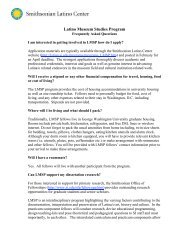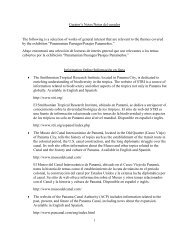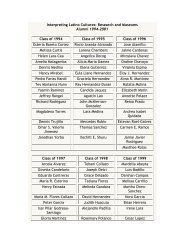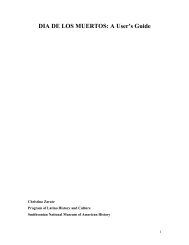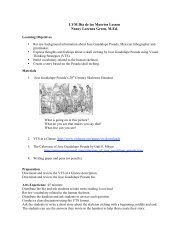Research and Museums - Smithsonian Latino Center - Smithsonian ...
Research and Museums - Smithsonian Latino Center - Smithsonian ...
Research and Museums - Smithsonian Latino Center - Smithsonian ...
You also want an ePaper? Increase the reach of your titles
YUMPU automatically turns print PDFs into web optimized ePapers that Google loves.
The Interpretation<strong>and</strong> Representation of<strong>Latino</strong> Cultures:<strong>Research</strong> <strong>and</strong> <strong>Museums</strong>strate the epic scale <strong>and</strong> thematic complexity of early twentieth-century border culture. In thiswork, Gadsden, Arizona represents the most recent frontier acquisition in the United States, thefinal state of the continental Union, a continuation of modern Mexico, an internal Orient namedAztlan. This first generation of Carmelite priests in southern Arizona returned to Iberia to replacefallen comrades during the Spanish Civil War. Thereafter, their imprint became a template uponwhich later generations of community leaders traced their cultural objectives. Almost a centuryafter their arrival, the record of their presence represents a breakthrough in public history aboutregional Mexican-American culture.Illustrating Cultural AuthorityMedicalized Representations of Mexican Communities in Early 20 th Century Los AngelesNatalia Molina, Ph.D.This presentation explores the cultural authority of public health within the urban space of LosAngeles. Using pictures published in Los Angeles City Health Department reports during the1910s <strong>and</strong> 1920s, I argue that public health officials played an important role in the productionof medicalized cultural images of Mexicans, some of which are still with us today. These imagesfostered the public’s underst<strong>and</strong>ing of Mexican communities. Health officials believed Mexicanscould be initiated into American culture through health <strong>and</strong> hygiene programs. Many of the publishedphotographs of Mexicans focused on both Mexicans themselves <strong>and</strong> their homes.Normative domestic scenes had already been established through extensive boosterism <strong>and</strong> realestate promotions that depicted Los Angeles as an urban Eden equipped with showcase homessurrounded by manicured lawns. In contrast, health department photographs presented Mexic<strong>and</strong>omesticity as inferior <strong>and</strong> their homes as sites of disease. In addition, a large series of “before<strong>and</strong> after” health department photographs documented the ameliorative effects of public healthinstruction focusing on women, particularly mothers. Many of these photographs depict the visitingpublic health nurses <strong>and</strong> the effects their instruction had on mothers <strong>and</strong> by extension, thehome. By affecting change in the private sphere, health officials beloved Mexicans would be moreprepared to participate in public life. Reading the photographs as texts both demonstrates howscience produces cultural images of ethnic groups <strong>and</strong> allows us a glimpse into the private lives ofworking-class Mexicans who otherwise left few enduring records from this time period. The photographsreveal a multi-layered narrative of resistance <strong>and</strong> accommodation.Cri<strong>and</strong>o Historia <strong>and</strong> Capturing ImagesRepresentation <strong>and</strong> Reclamation of MestizajeEstevan Rael-Gálvez, Ph.D.New Mexico’s history has long been an object of fascination, in which the image of Hispanic NewMexicans is subject to particular constructions <strong>and</strong> imaginations. Nuevomexicano culture, community,<strong>and</strong> consciousness have thus been significantly determined by the issue of representation.These historical representations have involved a number of entities, including individual writers<strong>and</strong> photographers. State <strong>and</strong> federal agencies such as the New Mexico Department of Tourism,32 <strong>Smithsonian</strong> <strong>Center</strong> for <strong>Latino</strong> Initiatives



